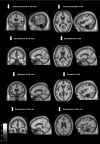Neuroanatomical profiles of personality change in frontotemporal lobar degeneration
- PMID: 21372059
- PMCID: PMC3093679
- DOI: 10.1192/bjp.bp.110.082677
Neuroanatomical profiles of personality change in frontotemporal lobar degeneration
Abstract
Background: The neurobiological basis of personality is poorly understood. Frontotemporal lobar degeneration (FTLD) frequently presents with complex behavioural changes, and therefore potentially provides a disease model in which to investigate brain substrates of personality.
Aims: To assess neuroanatomical correlates of personality change in a cohort of individuals with FTLD using voxel-based morphometry (VBM).
Method: Thirty consecutive individuals fulfilling consensus criteria for FTLD were assessed. Each participant's carer completed a Big Five Inventory (BFI) questionnaire on five key personality traits; for each trait, a change score was derived based on current compared with estimated premorbid characteristics. All participants underwent volumetric brain magnetic resonance imaging. A VBM analysis was implemented regressing change score for each trait against regional grey matter volume across the FTLD group.
Results: The FTLD group showed a significant decline in extraversion, agreeableness, conscientiousness and openness and an increase in neuroticism. Change in particular personality traits was associated with overlapping profiles of grey matter loss in more anterior cortical areas and relative preservation of grey matter in more posterior areas; the most robust neuroanatomical correlate was identified for reduced conscientiousness in the region of the posterior superior temporal gyrus.
Conclusions: Quantitative measures of personality change in FTLD can be correlated with changes in regional grey matter. The neuroanatomical profiles for particular personality traits overlap brain circuits previously implicated in aspects of social cognition and suggest that dysfunction at the level of distributed cortical networks underpins personality change in FTLD.
Figures



References
-
- Ryckman R. Theories of Personality. Thomson/Wadsworth, 2004.
-
- Goldberg LR. An alternative ‘description of personality’: the big-five factor structure. J Pers Soc Psychol 1990; 59: 1216–29. - PubMed
-
- McCrae RR, Costa PT. The structure of interpersonal traits: Wiggins’s circumplex and the five-factor model. J Pers Soc Psychol 1989; 56: 586–95. - PubMed
-
- Peabody D, Goldberg LR. Some determinants of factor structures from personality-trait descriptors. J Pers Soc Psychol 1989; 57: 552–67. - PubMed
-
- Kaasinen V, Maguire RP, Kurki T, Brck A, Rinne JO. Mapping brain structure and personality in late adulthood. Neuroimage 2005; 24: 315–22. - PubMed
Publication types
MeSH terms
Grants and funding
LinkOut - more resources
Full Text Sources
Other Literature Sources
Medical

